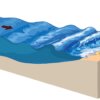Extreme weather events like earthquakes, tsunamis, heavy winds and hurricanes should be considered when planning a dredging operation.
These extreme weather events are natural events but in recent years, given the effects of global warming, there seems to be an increase in their frequency and strength. According to the most recent Intergovernmental Panel on Climate Change (IPCC) report (2007) climate-related changes over the 21st century will include an acceleration in sea level rise, further rise in sea surface temperature, more extreme weather events and storm surges, altered precipitation and ocean acidification. This could result in a 50% increase in areas that are vulnerable to flooding. At coastal zones and deltas these climate-related changes are expected to have a range of physical, economic and social impacts.
Rising sea levels will increase the flood-risk and erosion along the coast, but may also impact freshwater availability or result in an accelerated loss of coastal ecosystems like wetlands and mangroves.
Weather Events
Climate experts emphasise the importance of adapting to these potential effects by developing and implementing coastal protection and adaptation strategies for coastal regions. Each of the four weather types listed below can contribute to the potential for damages:
- Earthquakes: Earthquakes can cause liquefaction of soil because during an earthquake the soil loses its strength or stiffness as pore water pressure changes resulting in failure and landslides.
- Tsunamis: Tsunamis are large waves on the ocean, usually caused by an undersea earthquake, a volcanic eruption, or coastal landslide, which can cause extreme damage.
- Wind: Wind does not usually cause disturbance to the fill, but wind can affect other aspects of a dredging project like damaging equipment and harming personnel.
- Hurricanes /Typhoons: A hurricane or typhoon is a severe weather event with wind and rain that can cause extensive damage and flooding both inland and on the coastlines.
Such weather events need to be considered during the planning stages of a dredging project. By doing so, dredging techniques to some extent can be utilized to increase coastal protection and minimize damages.









